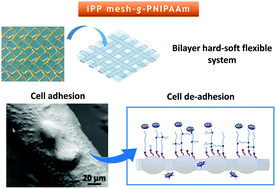当前位置:
X-MOL 学术
›
J. Mater. Chem. B
›
论文详情
Our official English website, www.x-mol.net, welcomes your
feedback! (Note: you will need to create a separate account there.)
Polypropylene mesh for hernia repair with controllable cell adhesion/de-adhesion properties.
Journal of Materials Chemistry B ( IF 6.1 ) Pub Date : 2020-01-15 , DOI: 10.1039/c9tb02537e Sonia Lanzalaco 1 , Luis Javier Del Valle 1 , Pau Turon 2 , Christine Weis 2 , Francesc Estrany 1 , Carlos Alemán 1 , Elaine Armelin 1
Journal of Materials Chemistry B ( IF 6.1 ) Pub Date : 2020-01-15 , DOI: 10.1039/c9tb02537e Sonia Lanzalaco 1 , Luis Javier Del Valle 1 , Pau Turon 2 , Christine Weis 2 , Francesc Estrany 1 , Carlos Alemán 1 , Elaine Armelin 1
Affiliation

|
Herein, a versatile bilayer system, composed by a polypropylene (PP) mesh and a covalently bonded poly(N-isopropylacrylamide) (PNIPAAm) hydrogel, is reported. The cell adhesion mechanism was successfully modulated by controlling the architecture of the hydrogel in terms of duration of PNIPAAm grafting time, crosslinker content, and temperature of material exposure in PBS solutions (below and above the LCST of PNIPAAm). The best in vitro results with fibroblast (COS-1) and epithelial (MCF-7) cells was obtained with a mesh modified with a porous iPP-g-PNIPAAm bilayer system, prepared via PNIPAAm grafting for 2 h at the lowest N,N'-methylene bis(acrylamide) (MBA) concentration (1 mM). Under these conditions, the detachment of the fibroblast-like cells was 50% lower than that of the control, after 7 days of cell incubation, which represents a high de-adhesion of cells in a short period. Moreover, the whole system showed excellent stability in dry or wet media, proving that the thermosensitive hydrogel was well adhered to the polymer surface, after PP fibre activation by cold plasma. This study provides new insights on the development of anti-adherent meshes for abdominal hernia repair.
中文翻译:

用于疝气修复的聚丙烯网具有可控制的细胞粘附/去粘附特性。
在此,报道了由聚丙烯(PP)网和共价键合的聚(N-异丙基丙烯酰胺)(PNIPAAm)水凝胶组成的通用双层系统。通过控制PNIPAAm接枝时间的持续时间,交联剂含量和PBS溶液中材料暴露的温度(PNIPAAm的LCST之下和之上)来控制水凝胶的结构,可以成功地调节细胞粘附机制。用多孔iPP-g-PNIPAAm双层系统修饰的网孔获得成纤维细胞(COS-1)和上皮细胞(MCF-7)的最佳体外结果,该网孔通过在最低N,N下以PNIPAAm接枝2 h制备-亚甲基双(丙烯酰胺)(MBA)浓度(1 mM)。在这些条件下,培养7天后,成纤维细胞样细胞的脱落比对照的脱落低50%,这表示在短期内细胞的高粘附力。而且,整个系统在干或湿介质中均显示出极好的稳定性,证明在通过冷等离子体活化PP纤维后,热敏性水凝胶可以很好地粘附于聚合物表面。这项研究为腹疝修补术的抗粘连网的发展提供了新的见解。
更新日期:2020-02-13
中文翻译:

用于疝气修复的聚丙烯网具有可控制的细胞粘附/去粘附特性。
在此,报道了由聚丙烯(PP)网和共价键合的聚(N-异丙基丙烯酰胺)(PNIPAAm)水凝胶组成的通用双层系统。通过控制PNIPAAm接枝时间的持续时间,交联剂含量和PBS溶液中材料暴露的温度(PNIPAAm的LCST之下和之上)来控制水凝胶的结构,可以成功地调节细胞粘附机制。用多孔iPP-g-PNIPAAm双层系统修饰的网孔获得成纤维细胞(COS-1)和上皮细胞(MCF-7)的最佳体外结果,该网孔通过在最低N,N下以PNIPAAm接枝2 h制备-亚甲基双(丙烯酰胺)(MBA)浓度(1 mM)。在这些条件下,培养7天后,成纤维细胞样细胞的脱落比对照的脱落低50%,这表示在短期内细胞的高粘附力。而且,整个系统在干或湿介质中均显示出极好的稳定性,证明在通过冷等离子体活化PP纤维后,热敏性水凝胶可以很好地粘附于聚合物表面。这项研究为腹疝修补术的抗粘连网的发展提供了新的见解。






























 京公网安备 11010802027423号
京公网安备 11010802027423号